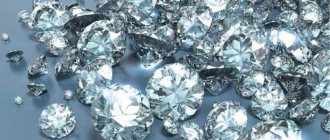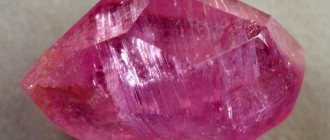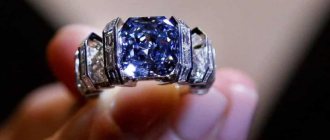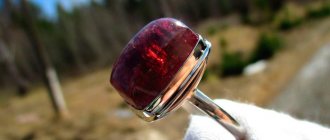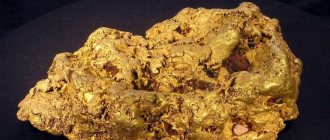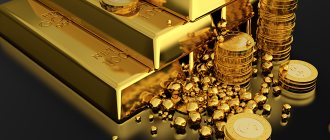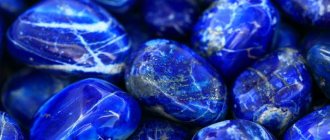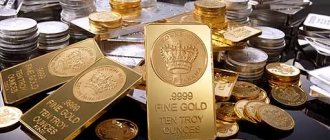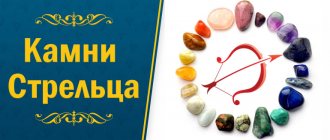Today, the jewelry industry has reached such a level that fashionable and beautiful products are made from almost any material. Conventional precious stones often fade into the background, giving way to more budget-friendly semi-precious and ornamental stones. But not all customers know how the inserts differ from each other and why prices vary so much for minerals that are similar in appearance. To understand this, let’s take a short excursion into the history of the jewelry industry and consider each type of insert separately.
Gems
The most expensive and most valuable inserts. What is the reason for the high cost of such minerals? Let's figure it out in order.
The first thing to consider is that gems are natural minerals formed in a complex way in the earth’s crust. Accordingly, a gemstone can be called such only if it is rare in nature .
Jewelry with cognac diamonds in the “Chocolate” collection
Let us present some statistical data from world practice. The relative cost of mining the most expensive stones as a percentage of the cost of total mining at the beginning of the 21st century was as follows: emeralds - 43, rubies - 14, opals - 10, sapphires - 6, jadeite - 6, turquoise - 5, other colored stones - 16%. This shows that the high cost of precious stones is due, first of all, to the complexity of their extraction.
What other indicators can identify a gemstone among all the others?
Hardness _ The mineral should not be exposed to external influences - scratched or chipped. In Russia, in accordance with the Federal Law “On Precious Metals and Precious Stones,” this list includes natural diamonds, emeralds, rubies, sapphires, alexandrites, and pearls. Unique amber formations are also considered precious stones. From this we see that its high cost is quite understandable.
In addition, the degree of its fashionability . Simply put, the more an accessory falls under the definition of a “fashion trend,” the higher its cost.
The world of precious stones is very large and, unfortunately, confusing, especially when viewed superficially. At the moment, over 2.5 thousand minerals are known, but only a little more than a hundred of them are valuable from the point of view of the jewelry industry and decorative arts.
It is quite difficult to understand the intricacy of varieties of precious, semi-precious and ornamental stones, but there are also valuable natural formations that are not minerals. Therefore, within the framework of this publication, several approaches to the classification of valuable minerals and natural formations will be considered.
What determines the cost of a stone?
Today, there are five criteria that directly affect the price of a crystal.
Weight
The most obvious point is that the heavier the stone, the larger it is, the more expensive it is. The main unit of measurement is the carat, equal to 0.2 grams. Next, the average market tariff is included in the calculation; here, each mineral has its own “critical” mass. For example, you will not find jewelry with a diamond even half a carat in a regular store, because its cost will be around 500 thousand rubles, but for a ruby this weight or even more is considered the norm.
Color
Jewelry making is a strict compliance with standards; it is not for nothing that everything associated with a noble profession is considered synonymous with precision. This approach also affected the shades of stones, where 14 colors were taken as standards, except for transparent, which is indicated separately:
- Green;
- Red;
- Yellow;
- Black;
- Pink;
- Orange;
- Grey;
- Blue;
- Blue;
- Violet;
- Brown;
- Black;
- White;
- Multicolor.
It should be understood that it is not only the color palette that determines the value. Maximum compliance with the standard is also important. When the shade of cut raw materials is too light or dark, its value decreases, which is good for the buyer, but not for the master jeweler.
Ennoblement
The vast majority of stones, except for transparent ones, end up on store shelves with “pumping” of color, that is, ennobled. This word refers to laboratory procedures, the purpose of which is to bring the blank of future inlay into conformity with its presentation. There are 5 common methods actively used by manufacturers:
- Heating is technologically simple, when pre-cut stones are placed in a special furnace, where they are heated to extreme temperatures. This allows you to even out the shade, make it more saturated or, conversely, mute it.
- Diffusion is an advanced heating method in which each workpiece is pre-coated with ions of a particular metal that serves as a color catalyst. After cooling, the transformation of the shade remains for many years or forever.
- Sputtering is a technology that gave birth to the famous mystic topaz, which has the effect of an iridescent kaleidoscope. It was invented in 1993 in the USA, when a special film of titanium composition was applied to the surface of the mineral.
- Irradiation – radiation allows you to change and “tweak” colors throughout the rainbow spectrum, the main thing is to correctly calculate the dose. The downside is the need to keep processed gems in sealed lead capsules for months.
- Glass filling - more precisely, a special type of crystal is used, which hides physical defects, voids and cracks without damage. According to Russian GOST, up to 50% of the volume is allowed; if more, the stone receives the status of composite.
As you might guess, crystals with minimal changes are valued more than others, but they are found extremely rarely in nature, and in the case of rubies or sapphires they are simply on the verge of fantasy. It is important for the buyer to remember that even an ennobled gem continues to remain precious, and minor interventions do not in any way affect its beauty.
Purity
The most controversial parameter, since many experts call the so-called inclusions in the structure of a mineral perhaps the main criterion of authenticity. Heterogeneity is inherent in any natural element, but jewelry precision requires the strictest classification, so there is a gradation of purity that divides stones as follows:
- Group 1 – the maximum possible shine and transparency, flaws in the structure are visible only under an electron microscope or a strong magnifying glass.
- Group 2 – there are subtle defects that can be seen with a household office magnifying glass.
- Group 3 – inclusions visible to the naked eye, slightly dimming transparency and optical effects.
- Group 4 – fairly large flaws, gloss significantly lower than the standard.
- Group 5 – the crystal structure is damaged, cracks and cavities are present, serious refining is required.
Depending on the manufacturer, a code is indicated on the jewelry tag, most often in the form of a decimal fraction. It should be read with the resulting number so that it is as close to the whole as possible. For example, 3/1 means exceptional quality, pure inlay, but 3/6 results in 0.5 - we have a low-grade insert, close to the fifth group.
Cut shape
It’s relatively simple here - automation of production bases has made life easier for many jewelers, however, intricate shapes still require painstaking manual labor. The following styles are considered popular among buyers, regardless of the category of stone:
- Circle;
- Square;
- Baguette;
- Cabochon;
- Oval;
- Heart;
- Marquis;
- Princess;
- Pear;
- A drop.
Of course, there are a dozen patented cuts - Antwerp rose, happy, magna and many others. Each of them reveals the iridescent brilliance of the gem in its own way, but no one has canceled the rule of labor costs - the more complex the composition, the more expensive the results.
What types of gems are there?
The names of precious stones and minerals (which, in fact, are the same thing) are presented differently in different classifications, since a unified system has not yet been developed. From a generally accepted point of view, only the most beautiful, rare and expensive minerals and other natural formations can be considered precious stones.
According to Article 1 of the Federal Law of March 26, 1998 No. 41-FZ, officially precious stones are exclusively diamonds, rubies, emeralds, alexandrites and sapphires, as well as pearls of natural origin, that is, organics. Amber is also sometimes included here, but with certain unique features - special inclusions, heavy weight, and so on.
Ring from the “Diamonds of Yakutia” collection in Sunlight
However, there are also nuances here: precious stones in jewelry look very impressive and cost accordingly. But very small or defective minerals lose a lot in value, while semi-precious semi-precious gems of large sizes and rare colors can be equal in value to first-order precious stones.
The science that studies precious stones is called gemology. This is a special section of mineralogy devoted to precious, jewelry, semi-precious and ornamental stones.
Table of precious stones according to the classification of the prominent Soviet and Russian mineralogist E.Ya. Kievlenko seems the most logical and easy to understand. Based on it in the light of modern realities, Doctor of Geological and Mineralogical Sciences E.P. Melnikov proposed an improved version of the classification.
Without going into detail, there are four groups of valuable minerals:
- Gems. Diamond, classic blue sapphire, ruby, alexandrite, emerald and natural sea pearls.
- Jewelry stones. They are divided into four orders. Among the most famous: sapphires of fancy colors, spinel, opals, tanzanite, various types of beryl and corundum (except precious ones), tourmalines, zircons, garnets, freshwater and sea cultured pearls, amethyst, aquamarine, citrine, tiger and cat's eye, apatite, mother of pearl, certain types of quartz and others.
- Jewelry and ornamental stones. Malachite, turquoise, jadeite, lapis lazuli, pink and smoky quartz, jasper, ordinary opals, rock crystal, special grades of jasper, jade, agate, chrysoprase and others.
- Ornamental stones. Jasper, marble onyx, jet, goldite, obsidan, certain types of granite and other ornamental materials of mineral origin.
In addition to pearls, the classifier also includes other materials of organic origin. These are corals, mammoth and ivory. They are considered jewelry and ornamental stones.
Ornamental stones
This category includes all minerals that are suitable for glyptics - stone cutting. They serve as the basis for the manufacture of figurines, netsuke, cameos, and decorative boxes. Glyptics are valuable not only for their natural beauty, but also for the hardness of the raw material and the ability to process it.
Raw emerald
The name “ornamental stones” is also conditional: modern craftsmen carve amethyst, beryl and even emerald. Gemologists classify the following minerals as ornamental stones: jets, jaspilites, listvenites, marble onyx, aventurine quartzite, jasper, obsidian, fluorites, selenites, agalmatolites, samples of written granite, petrified wood, patterned stone, banded skarn, colored marble.
All of the above categories apply only to natural gems. Synthetic crystals grown in a laboratory, imitations of natural minerals, cannot be classified as one of them.
The most expensive gems
We will not repeat the above: the most expensive in the ranking of precious stones in terms of value are the last five positions described above. These are gems of the first order and the highest value according to any classification.
But you need to understand that it is impossible to compile an objective list of stones by value: the cost of a carat of a mineral depends not only on its chemical formula, but also on purity, transparency, size, color, presence/absence of defects and other parameters.
Therefore, in this nomination we will present the rarest and most expensive minerals that go beyond generally accepted standards. So, here is a list of truly unique stones, valued at fortunes:
- Tsavorite. Jewelry garnet is yellowish-green in color. A carat costs about 3-5 thousand US dollars.
- Sapphire. An unheated stone of pure blue color is estimated at a minimum of 4.5-6 thousand dollars/carat.
- Red spinel. It is considered one of the fastest growing minerals in price: the cost is 6-8 thousand dollars per carat.
- Demantoid. Another green garnet, but a piercing pure color. Ural demantoid costs about 10 thousand dollars/carat.
- Paraiba. Neon blue tourmaline that glows in the dark. Average quality stones cost 8-12 thousand dollars/carat.
- Emerald. Flawless pure emeralds are extremely rare. The cost of a carat of high-quality unoiled emerald starts from 10-13 thousand dollars
- Padparadscha. The sapphire is an incredible orange-pink color. Cost – 10-12 thousand dollars/carat.
- Alexandrite. The price of this stone ranges from 10-37 thousand dollars/carat. The most expensive are those mined in Russia.
- Ruby. A clean large stone of the top color “pigeon blood” is estimated at 15-25 thousand dollars/carat.
- Jade. The rarest transparent jadeite, known as “imperial”, costs at least 20 thousand dollars per carat.
- Diamond. The cost of a high-quality colorless diamond is about 15 thousand dollars per carat. A blue diamond costs about 30-50 thousand. And the most expensive gemstone in the world is the red diamond: a carat is estimated at 500 thousand - 1 million dollars.
Paraiba Tourmaline
Top 10 most expensive stones in the world
It may sound ironic, but the most valuable minerals are never used in mass jewelry production; a simple buyer is unlikely to ever be able to see them on store shelves. The reason is banal - they are so rare in nature that literally every gem obtained is sent to natural science museums or private collections.
First place. Red Diamond
Price for 1 carat – from $1,000,000
The undisputed record holder is the carbon compound that forms a blood-red diamond crystal. In the entire history of mankind, only 30 nuggets have been found, 70% of which have a nominal weight of less than 1 carat. Each auction with such a lot is truly a world event, and the starting price tag of a million US dollars will seem like a mere trifle compared to the total amounts for which they are sold.
Second place. Taaffeit
Price 1 carat – $35,000
If the Austrian gemologist Richard Taaffe had not sent a piece of faceted spinel of a strange dark purple color that he found in Dublin in 1945 for examination, we would never have known about his name stone. This compound is unlike any known mineral, and its unique hue, coupled with its natural rarity, found exclusively in China, has made it one of the record holders for jewelry value - twice as expensive as a diamond.
Third place. Grandidierite
Price 1 carat – $20,000
The turquoise heart of Madagascar almost stopped beating when the last vein, discovered before the First World War, dried up in the sixties. This largely determined the high cost of blue stones with a unique pearlescent sheen inside. Today, on the southern tip of the African island, 2-3 nuggets are mined per year, each of which receives a certificate of authenticity for further cutting and inlay.
Fourth place. Serendibit
Price 1 carat – $18,000
The Serendib mineral, which received the Arabic name of the island of Sri Lanka, began to be mined back in 1902, but over the course of a century it was possible to find hardly more than a couple of dozen stones. At first glance, it is a coal-black crystal, but when bright sunlight hits it, a bright blue, greenish or yellow light “lights up” inside. For its “alien” texture, it earned a truly magical reputation and a market value that is 20% more expensive than a diamond.
Fifth place. Red beryl
Price for 1 carat – $10,000
The pride of Utah made several generations of prospectors multimillionaires until Bixbite, as the Americans call it, was discovered in southern New Mexico. Nowadays, the rarest shade of beryllium silicate is found much more often than 20 years ago, but its cost does not yet appear to decrease. The most valuable examples are deep purple stones; the blood red hue is more affordable, but still cannot be found outside the United States.
Sixth place. Musgravit
Price 1 carat – $6000
A relict mineral from Australia, whose homeland is the mountain range with the gloomy name Musgrave. According to the molecular formula, it is an oxide compound of magnesium with beryllium, which gives three natural colors - gray-transparent, olive green and lavender. It rightly tops the ratings of the rarest jewelry minerals - over its half-century history, only 15 pieces of jewelry inlaid with this stone have been officially registered.
Seventh place. Benitoite
Price 1 carat – $4000
California sapphire, as it is informally nicknamed by connoisseurs, is mined in the only deposit on the planet, located near San Benito County. The structure is barium silicate with strong inclusions of titanium, due to which a unique deep shade of blue is obtained. Another interesting property is the fluorescent effect, which is activated by direct exposure to ultraviolet light and lasts for at least several hours.
Eighth place. Poudretteite
Price 1 carat – $3000
Very little is known about the mineral, except that it received its name from the surname of the owner of the mining company, the only mines of which are located in Canada and Myanmar. This is an extremely fragile crystal, famous for its “glamorous” color palette - from pastel purple to bright pink, almost never found in nature. Since 2000, a little more than 30 nuggets suitable for further cutting and sale have been found.
Ninth place. Fire opal
Price 1 carat – $2500
Unlike regular semi-precious silica, its hyacinth-colored counterpart boasts exceptional transparency, which determines its high price. It is known for certain that the rings of Roman emperors were decorated with fire opals. The tradition passed on to monarchical Europe - Napoleon Bonaparte adored such stones and even gave his wife Josephine a faceted masterpiece worth 30 thousand Venetian ducats in gold.
Tenth place. Eremeevit
Price 1 carat – $2000
The first stone, named after the great Russian mineralogist Pavel Eremeev, was found in the Transbaikal mines at the end of the 19th century, but it received a detailed scientific description only 70 years later. This is a unique aluminum borate compound that has a delicate bluish tint that resembles freshly set ice. When heated, it can change color to green, but as soon as it cools down, it returns to its original appearance.
What is the difference between precious and semi-precious
There are no objective parameters that distinguish precious stones from semi-precious ones. The main criterion in this case is the price: semi-precious ones are inexpensive, precious ones are not accessible to everyone.
In the classification of the All-Russian Research Institute of Jewelry Industry there is no concept of precious and semi-precious stones at all: they can be jewelry, semi-precious and jewelry-precious.
Precious stones mined in Russia are highly valued on the world market. Moreover, the Russian Federation has deposits of almost all precious minerals, with the possible exception of rubies.
What is considered a precious metal?
According to Russian legislation, eight items are included in the group of precious metals:
- gold;
- silver.
Platinoids:
- platinum;
- ruthenium;
- palladium;
- rhodium;
- iridium;
- osmium.
The list of precious metals is determined by GOST of Russia - R 52793-2007 (read GOST R 52793 - 2007).
The main types of precious metals are gold, silver, and the platinum segment (platinum group metals).
The second name for precious metals is noble metals.
Classification of stones by properties
The classification of precious stones takes into account all kinds of physical, optical and other characteristics. The most obvious characteristic of gemstones is their weight. With all other qualities being equal, a carat of a large mineral will cost more than a similar unit of a small one (sometimes by several times).
Carat is a unit of weight of precious stones, accepted by jewelers all over the world. One carat is only 0.2 grams!
All other properties of precious stones can be combined into the following broad groups:
- Rarity. The rarer the mineral, the higher its value. It’s enough for a large deposit to be depleted, and the stone immediately soars in price.
- Feeling. Tactile sensations when touched (“soapiness”, slipperiness, etc.).
- Density. The denser the stone, the heavier it is. Zircon is even heavier than diamond. The lightest is amber.
- Hardness. Here it is appropriate to mention the Mohs scale, which grades the hardness of substances according to a ten-point system, from diamond (10) and corundum (9) to talc. Test - surface scratching.
- Strength. A very hard stone may not be very durable and will easily crack under physical stress. Not too hard jade is very difficult to split due to its high viscosity, and zircon crumbles instantly.
- Cleavage. The description of this characteristic is quite difficult: it is the “behavior” of the stone when splitting (in which directions it splits). It is fundamentally important when cutting.
- Electrification and polarity. For the jewelry industry, these parameters are not important.
- Transparency. Gemstones are usually transparent or translucent. The purer the stone, the more valuable it is.
- Color. Multi-colored stones can be more valuable or cheaper than their classic counterparts. Examples were given above.
- Shine. Can be diamond, glass, silky, mother of pearl and so on.
- Light refraction. A characteristic that is fundamentally important when choosing a cut.
- Dichroism and polychroism. The ability of a stone to change color depending on the angle and intensity of light.
- Asterism. The effect of a “star” inside the stone when hit by light.
- Luminescence. The ability to glow, characteristic of diamonds, rubies, jade and other stones.
- Defectiveness. Presence, location, type and number of various defects.
- Quality of cut. The value of the mineral directly depends on the quality of the cut.
- Ennoblement. A stone with good natural characteristics will always cost more than its improved (heated, oiled, painted, etc.) counterpart.
Classification by groups
One of the difficulties in dividing precious stones into groups is their names, many of which were assigned in ancient times. It happened that the name of a mineral came from the place of its extraction or from its color characteristics. For example, golden-colored stones were called topaz, blue minerals were called sapphires. In addition, one mineral could have several fixed names. To resolve this situation, modern mineralogy introduced the concepts of species, groups and varieties of minerals.
Now the type of mineral consists of crystals of the same chemical composition. For example, aluminum oxides are corundum, beryllium and aluminum silicate are beryl. Based on the degree of transparency of the mineral and its color characteristics, one type can be divided into varieties. Species similar in chemical composition form groups of minerals.
Group of pomegranates
The garnet group is a broad type of mineral that belongs to the silicate class.
Typical representatives of the group are grant, rhodolite, grossularide, andralite, pyrope. Garnet is a dark red mineral. This gemstone has many names. In particular, Pliny the Elder called a mineral similar to flickering coals a carbuncle (from “carbon” - “coal”). Garnets, along with other red gems, were sometimes called anfrax. In Ancient Rus', pomegranates were known as chervetsy, becheta, and venice.
Rhodolite is translated from Greek as “pink stone”. Rhodolites are a type of pyrope, which is a silicate from the garnet group. Large rhodoliths are relatively expensive.
Quartz group
Quartz is silica dioxide.
This is the most common mineral. Regular glass or translucent grains of sand on the beach are great examples of quartz. Quartz is a large group of minerals. In particular, rock crystal is nothing more than its transparent variety. Amethyst is a variety of quartz that is characterized by a violet color ranging from dark purple to pinkish.
Amethysts are mined in Brazil, Uruguay and Sri Lanka. Amethysts are relatively inexpensive; this fact is primarily explained by the presence of artificial amethysts on the market, which are extremely difficult to distinguish from natural ones. Jasper is a whole class of minerals that consist of siliceous rocks with various impurities: chalcedony, iron, aluminum; constituting up to 20% of the crystal. The Greek word “iaspis” is translated as “variegated,” which indicates the color diversity of this mineral.
Group of organic materials
Organic materials are formed by a living being and, to varying degrees, consist of organic and inorganic parts. This group of materials includes coral, pearls, amber and jet.
Pearls do not require additional processing. This material is formed in the body of mollusks inside the oyster bag. A mollusk, when a particle of a foreign substance enters its body, envelops it in layers of calcium carbonate, held together by organic matter. The more layers, the larger the pearl. The growth of pearl layers is a very slow process. Natural pearls are found not only in white colors. It can be yellow, blue, red and even black.
Feldspar group
Feldspars are silicon silicates that make up up to 50% of the mass of the earth's crust.
When feldspars break down, sedimentary rocks and clay are formed. Feldspars can often be found combined with quartz crystals. Feldspars include albite, labradorite, anorthite and other minerals. Labradorite is an opaque dark blue feldspar. If you polish this mineral well, you can achieve an interesting optical effect when golden, blue, indigo and green “lights” shimmer across the surface of the mineral. In Finland, labradors are mined, which are cast in all the colors of the rainbow. They are called spectrolites.
Group of Jades
Jades are a group of translucent minerals of pyroxene and amphibole composition.
Jades include: vesuvianite, grossularite, calcite, obsidian and chrysoprase. Jadeite is the same as jade. Jadeite is a type of jade, which is distinguished by impurities of sodium compounds.
The mineral is quite durable and well valued. Hard jadeite is highly polished, so the stone can be given shine. Chromium and iron give jadeite its green color. Particularly prized is the translucent “noble” or “imperial jade,” which is mined in Burma. Obsidians are volcanic glass. In nature, you can find obsidians in black, gray, yellow, red and brown colors. Gray-white obsidians are called snow obsidians. Pendants, pendants and rosaries are often made from this stone.
How to distinguish precious stones from artificial analogues
Artificial gemstones have the same composition as their natural counterparts. Moreover, they are, as a rule, of higher quality and purer than their natural counterparts. Various valuable crystals are grown under artificial conditions: diamonds, emeralds, rubies and others like them.
However, synthetic stones are much cheaper than natural ones (sometimes hundreds or even thousands of times). And this is explained by the fact that people tend to want to own something especially exclusive.
Almost all minerals remain cool for a long time. A fake made of glass or plastic quickly heats up in your hands. In this way, it is impossible to distinguish a precious stone from a non-precious one, but a crude imitation will immediately give itself away.
You need to understand that synthetic minerals are not fakes, that is, imitations (double stones or ordinary glass). If you buy a product in a large jewelry store, the chance of purchasing an artificial analogue or imitation without knowing it is surely close to zero. They simply won’t risk their reputation.
Gold ring with synthetic amethyst
Gold ring with natural amethyst
A non-professional will not be able to determine whether a gemstone is precious or not simply by eye. It is best to beware of buying jewelry second-hand or from small, dubious shops.
But if you somehow get your hands on a dubious specimen, an examination and evaluation of stones is at your service, which can be ordered at any jewelry workshop. Gross fakes are identified immediately, visually; in complex cases, more specific methods are required.
Extraction and production technologies
A ton of mined rock contains half a gram of precious metals. Global annual volumes (except for gold, silver and platinum) are symbolic – measured in tons. However, the cost is such that in monetary terms the precious material gets 5% (100 thousand times more than the share of production).
Precious metals are mined in three ways.
Extraction from the subsoil (primary) – method No. 1
Primary mining involves the extraction of precious metals from the ore mass, enrichment, and smelting of pure metal.
Gold mining
Gold mining is the leader in the precious metals segment. It is cost-effective to develop placers containing 0.11-0.51 g of metal per ton of total mass or primary deposits (1.1 - 4.9 g).
This production method is the main one today, but unpromising: expensive, environmentally dirty. Plus the depletion of deposits.
Recycling - method No. 2
Recycling is the processing of scrap to recover and reuse precious metal.
Recycling and recycling of precious metals from microcircuits
The assortment is wide. First of all, these are jewelry that has lost its aesthetic standards.
Sources of raw materials
Other sources of precious metals in secondary raw materials:
- Worn-out components of factory equipment, instrumentation, automation, batteries.
- Home appliances that cannot be repaired (TVs, refrigerators, radios, stereos).
- Industrial waste.
- Laboratory instruments (chemical glassware, other products).
- Fragments coated with such metals.
Laptops, smartphones, mining equipment, and other gadgets are rapidly moving into first place as a source of scrap.
The content of precious metals in secondary raw materials is two to three orders of magnitude higher than in natural sources of production.
pros
“Extraction” of used precious metal is promising:
- The technology is simpler, much cheaper, and does not pollute the environment.
- High percentage of precious metals (compared to ore extraction).
- An inexhaustible source of raw materials.
The properties of precious metals do not change after processing.
By using recycling, almost half of precious metals can be reused.
Associated production - method No. 3
Precious components are “removed” from ore material of mixed composition.
Interesting facts about gemstones
And now some fun facts:
- The rarest gemstone in the world is grandidierite. At the moment, only eight copies are known.
- One of the most impressive collections of precious stones in the world is the Diamond Fund in the Kremlin Armory, in Moscow.
- The hardest gemstone is, naturally, diamond. It is the hardest naturally occurring substance on Earth.
There are not so many deposits of precious stones in nature, these minerals are expensive, and not everyone can afford such luxury. Don’t be upset about this: only an expert can distinguish an artificial diamond or emerald from its natural counterpart. In addition, many semi-precious stones in a classy design look no less advantageous than prohibitively expensive top-end gems.
15.02.21
Semiprecious stones
These minerals are widely used to decorate jewelry, but are not classified as precious gems. Affordable semi-precious stones are popular among jewelers and connoisseurs of precious stones due to their wide selection of shades and textures.
Pomegranate
Semi-precious mineral of rich red color. Yellow, green and even black specimens are also found in nature.
Color range : red, yellow, green, brown, black pink, orange, colorless.
Properties : promotes accelerated regeneration and normalizes blood pressure.
Zodiac compatibility : Aries, Aquarius, Gemini.
Topaz
It is an aluminum silicate containing fluorine. Topaz is a beautiful multi-colored semi-precious mineral.
Color range: depends on the characteristics of the crystal lattice. Can be white, blue, red and yellow.
Properties : helps with ulcers, colitis, anorexia and bulimia.
Zodiac compatibility : Scorpio and Sagittarius.
Opal
This amorphous silica is composed of water and silicon oxide and is completely devoid of a crystal lattice.
Color range : blue, green, fiery, cat's eye.
Properties : has a beneficial effect on vision and heart function.
Zodiac compatibility : Scorpio and Pisces.
Zircon
A bright semi-precious stone makes a woman more attractive in the eyes of men.
Color range : reddish brown, yellow gray, green, colorless.
Properties : helps fight colds and inflammation.
Zodiac compatibility : Aries and Aquarius.
Spinel
A rare gem for sincere people. Often used as an analogue of ruby.
Color range : transparent, red, pink, purple, yellow.
Properties : normalizes the functioning of the internal organ system, reduces headaches.
Zodiac compatibility : Pisces and Virgo.
Aquamarine
The aquamarine mineral is a beryllium aluminosilicate with a ring structure. The name of the gem consists of two Latin words and is translated as sea water.
Colors: blue, light blue, green.
Properties : reduces itching, urticaria and other allergic reactions.
Zodiac compatibility : Scorpio and Taurus.
Rhodolite
A surprisingly elegant pinkish-red stone from the garnet family of minerals.
Color scheme : pink-red.
Properties : helps with bronchitis, asthma, tuberculosis.
Zodiac compatibility : Sagittarius and Leo.
Chrysolite
Magic amulet of the Egyptian pharaohs.
Color range : various shades of green.
Properties: useful for stress and poor vision.
Zodiac compatibility: Leo and Virgo.
Amethyst
This semi-precious mineral of the second order is considered an amulet of spiritual enlightenment.
Color range: shades of lilac, lavender, purple.
Properties : a stone heated in the hands is applied to the temples and forehead to relieve headaches.
Zodiac compatibility : Aries and Aquarius.
Organic stones
Gems of organic origin are classified into a separate group . The most valuable are natural sea pearls, formed in oyster shells. Some pearls cost millions of dollars.
Coral jewelry is cheaper, but it is even more “alive”, because coral is a polyp, an invertebrate marine animal. Amber, which is formed when resin hardens on coniferous trees, also belongs to the organic group. Sometimes an insect lands on the resin, which then cannot tear itself away from the sticky surface and ends up in a trap. New layers of substance are superimposed on top and as a result, a mosquito or butterfly is completely enclosed in amber. Samples with inclusions are more expensive than regular ones.
How to choose a stone for your favorite jewelry?
If you want to have a talisman jewelry and wear it often, then it is advisable to choose an insert not only based on price and beautiful shine. It is also necessary to take into account whether the inlay color matches the eyes and skin tone. Natural stones are credited with magical and healing properties, and each one has their own. If you believe in the mystical power of rocks, this criterion also needs to be taken into account. Also, talisman stones are chosen according to horoscope, name, month or year of birth. If you successfully choose a piece of jewelry with a natural mineral, it will not only decorate your appearance, but also bring good luck in life.
25.03.21

